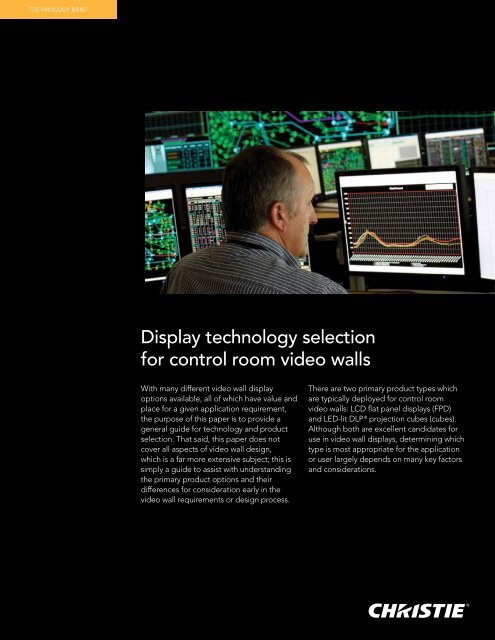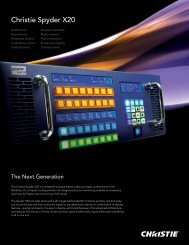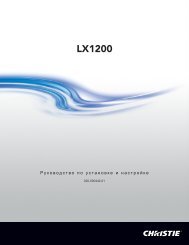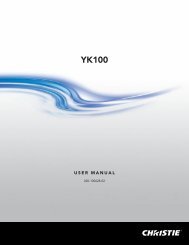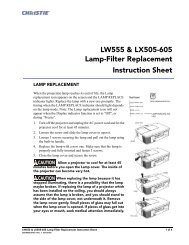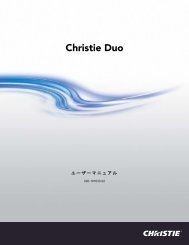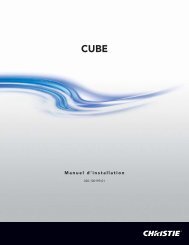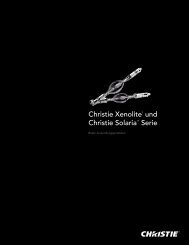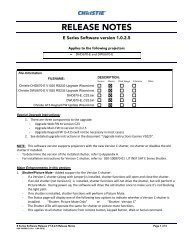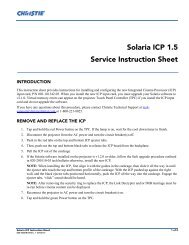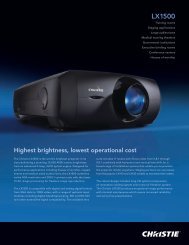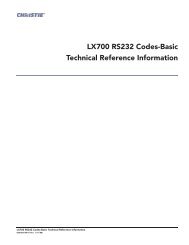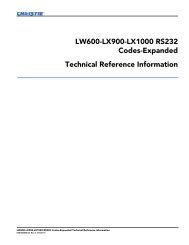Projection or flat panels for videowalls? - Christie Digital Systems
Projection or flat panels for videowalls? - Christie Digital Systems
Projection or flat panels for videowalls? - Christie Digital Systems
You also want an ePaper? Increase the reach of your titles
YUMPU automatically turns print PDFs into web optimized ePapers that Google loves.
Considerations f<strong>or</strong> video wall product selection FPDs CubesViewability • •Brightness • •Brightness unif<strong>or</strong>mity•Contrast • •Auto brightness and col<strong>or</strong> balancing•Gaps/seams between screens•Image retention•Image degradation•Video wall footprint•Initial system price•Total cost of ownership – 24/7•• = Best/typicallybest optionDisplay technologyConsiderations f<strong>or</strong> videowall product selectionViewabilityHow easy is it to see display inf<strong>or</strong>mation from different anglesand room locations? Both FPDs and cubes are designed tomaximize the viewability of inf<strong>or</strong>mation when the user is notdirectly in front of the display screen. However, as you movefurther off-angle from the display, brightness, and possiblycol<strong>or</strong>, may be affected, thus it is imp<strong>or</strong>tant to verify the productperf<strong>or</strong>mance specifications in advance. F<strong>or</strong> cubes, opticalscreens are typically used and each type has its own uniqueviewability characteristics. F<strong>or</strong> FPDs, viewability characteristicscan vary based on the LCD panel manufacturer. Both solutions(cubes and FPDs) can provide very good viewability characteristics,but during product selection it is imp<strong>or</strong>tant to ensure theactual characteristics f<strong>or</strong> a selected product meets the designrequirements set f<strong>or</strong> the application.BrightnessBrightness requirements f<strong>or</strong> video wall applications varydepending on the actual application. F<strong>or</strong> instance, if the videowall is to be used in a signage application, brighter is usuallybetter as it attracts m<strong>or</strong>e attention and interest. Also, higherbrightness may be necessary to improve overall contrast inenvironments where ambient light is very high – such as theoutdo<strong>or</strong>s. However, f<strong>or</strong> control room applications, too brightcan be considered a negative. Many control rooms have peoplethat w<strong>or</strong>k and operate in front of the display wall f<strong>or</strong> a fullw<strong>or</strong>king shift. If the wall is very bright, those people may sufferfrom headaches <strong>or</strong> eye strain over time. On the other hand,if the wall is not bright enough, contrast will likely be too low,making it difficult to quickly and accurately discern inf<strong>or</strong>mationas required. F<strong>or</strong> typical control room applications, a nominalbrightness of 250 cd/m 2 is quite adequate and reasonable.Above 500 cd/m 2 may be too bright whereby brightness mustbe lowered and managed. FPDs and cubes vary in brightnessand size but can usually accommodate most requirements.If cubes are preferred f<strong>or</strong> high brightness applications, thenMicroTiles ® might be the best solution to consider.2
Display technologyIf brightness is not unif<strong>or</strong>m within eachscreen, the overall video wall may exhibit a“checkerboard” type appearance which maybe m<strong>or</strong>e noticeable if content is mostly staticand includes a full white background.Brightness unif<strong>or</strong>mityThis section covers brightness unif<strong>or</strong>mity within each displayscreen, not just across the entire video wall display. If brightnessis not unif<strong>or</strong>m within each screen, the overall video wall mayexhibit a “checkerboard” type appearance which is veryundesirable. The impact of this effect will be m<strong>or</strong>e noticeabledepending on the content displayed. F<strong>or</strong> instance, if thecontent is mostly static and includes a full white background,non-unif<strong>or</strong>m displays will likely be quite noticeable. On theother hand, if the displays have lots of video <strong>or</strong> static contentwith dark backgrounds, non-unif<strong>or</strong>m displays may be of muchless concern. Most cubes offer a unif<strong>or</strong>mity of 95% <strong>or</strong> better– which is quite good, while FPDs are typically not as high.Additionally, because unif<strong>or</strong>mity is not typically measured rightto the edge of the bezel on FPDs, it is recommended to actuallytest/view the product solution in advance with the contentbeing used to ensure that the unif<strong>or</strong>mity meets the expectationsf<strong>or</strong> the application.Auto brightness and col<strong>or</strong> balancingWhen multiple displays are used together in a tiled displayarray <strong>or</strong> video wall, it becomes very critical that brightnessand col<strong>or</strong> from display to display be well matched and remainthat way over time. Our eyes are very sensitive to even subtledifferences in col<strong>or</strong> across multiple displays, theref<strong>or</strong>e videowall display products include capabilities to finely adjust thecol<strong>or</strong> f<strong>or</strong> best matching perf<strong>or</strong>mance. However, over time,col<strong>or</strong> <strong>or</strong> brightness may slightly change <strong>or</strong> drift, requiringre-adjustment. A maj<strong>or</strong> benefit of cubes and MicroTiles ®versus FPDs is that projection technology allows col<strong>or</strong> sens<strong>or</strong>sand monit<strong>or</strong>ing to be embedded within the design so thatcol<strong>or</strong> and brightness can be constantly monit<strong>or</strong>ed andautomatically re-adjusted without human intervention.This occurs continuously and is transparent to the user.F<strong>or</strong> FPDs, col<strong>or</strong> and brightness must be manually re-measuredwith an external meter and re-adjusted on a regular interval.This creates disruption to the display wall, additional expenseand cyclical perf<strong>or</strong>mance variations.ContrastHigher contrast enables easier and faster recognition of theinf<strong>or</strong>mation displayed and reduces eye strain. F<strong>or</strong> controlroom design, the overall system contrast ratio is quite critical.This takes into account ambient lighting within the room aswell as the imaging from the video wall display. Typically,a system contrast ratio of >100:1 is what is required. Displayproducts themselves have their own contrast ratio which isused to help determine the overall system contrast ratio.F<strong>or</strong>tunately f<strong>or</strong> both FPDs and cubes, the display contrastratio is usually at least 1500:1, which is acceptable in mostenvironments and applications.3
FPDs - between screensCubes - between screens1st STREETStatic image displayedf<strong>or</strong> long durationWEBERSTATIONHESPLERFREECAROLINE ST. JACOB1st STREETImage remaining afterstatic image removedWEBERSTATIONCAROLINEDisplay technology1 2 3 4 5 61 2 3BezelsGapsCubes have the ability to minimize this transition by offering a gap betweenscreens of only 1mm. FPDs on the other hand, have a disadvantage in thatthey require a bezel which supp<strong>or</strong>ts the liquid crystal glass.Image retention is a reality f<strong>or</strong> all LCD <strong>panels</strong> and its severity will varydepending on the content displayed and the duration the <strong>panels</strong> areoperated. DLP technology does not have this same issue.Gaps/seams between screensIdeally, a video wall display should be completely seamless.That is to say, viewers should not notice <strong>or</strong> a see a transitionfrom one display screen to the next. But in reality, this is notpossible with the emissive display products and technologiescurrently available. However, cubes have the ability to minimizethis transition by offering a gap between screens of only 1mm.This 1mm space is typically required to allow f<strong>or</strong> expansion/contraction of the screen materials during temperature <strong>or</strong>humidity fluctuations. F<strong>or</strong>tunately, f<strong>or</strong> large display walls whereoperat<strong>or</strong>s and users are typically at least 3 meters (10 feet) away,1mm is considered negligible. FPDs on the other hand, havea disadvantage in that they require a bezel which supp<strong>or</strong>ts theliquid crystal glass. Most “narrow bezel” FPDs offer an “imageto image” transition of approximately 6mm, <strong>or</strong> slightly less. F<strong>or</strong>applications where there is lots of data displayed versus motionvideo, the bezels may be too large, causing too much dist<strong>or</strong>tionof the inf<strong>or</strong>mation being displayed.Image retentionAn effect that can occur with LCD based technology is whatis typically referred to as “image retention.” This occurswhen a static image is displayed f<strong>or</strong> a period of time, causingelectrically charged particles to collect at the electrodes ofthe LCD panel, which in turn affects the future behavi<strong>or</strong> of theLCD crystals. The outcome is that when the image is eventuallychanged, a “phantom” image of what was previously displayedmay be still visible, disrupting the new inf<strong>or</strong>mation beingdisplayed. Depending on the situation, this “phantom” imagecould remain permanently on the display. It is f<strong>or</strong> this reasonthat LCD panel suppliers rate their LCD <strong>panels</strong> f<strong>or</strong> only 20/7operation. Also, image retention is typically not coveredunder warranty. F<strong>or</strong> best practice, it is recommended to leavethe panel turned off f<strong>or</strong> at least 4 hours per day to allow theLCD crystals to “stabilize,” reducing the impact of retentionissues. It is also recommended to operate the <strong>panels</strong> at loweroperating temperatures within the rated specifications to helpminimize this effect.Image retention is a reality f<strong>or</strong> all LCD <strong>panels</strong> and its severitywill vary depending on the content displayed and the durationthe <strong>panels</strong> are operated. DLP ® technology does not havethis same issue. However, if the installation is not 24/7 <strong>or</strong> thedisplays are typically showing fast moving images such as vide<strong>or</strong>ather than static images such as data, maps, schematics, etc.,image retention may be less of a concern. Although displayperf<strong>or</strong>mance may degrade over time, it may be acceptable f<strong>or</strong>the understood usable life of the FPDs.4
Long term costsOwnership cost ($)FPD replacementInitial video wall purchaseFPD systemCube systemGenerally, f<strong>or</strong> FPDs running 24/7 <strong>or</strong> 20/7,plan f<strong>or</strong> a useful life of about three years.F<strong>or</strong> cubes and tiles, expect a useful life ofapproximately 6 years <strong>or</strong> m<strong>or</strong>e.Display technology0 12 3 4 5 6YearsTotal cost of ownership – 24/7This takes into account the initial equipment investment as wellas the ongoing operational costs such as power consumption,HVAC and maintenance. Generally, f<strong>or</strong> FPDs running 24/7 <strong>or</strong>20/7, plan f<strong>or</strong> a useful life of about three years. Although FPDscan usually survive beyond three years, the image degradationand imaging quality will likely require that the wall be replacedwithin that time. F<strong>or</strong> cubes and tiles, expect a useful life ofapproximately 6 years <strong>or</strong> m<strong>or</strong>e. These products are designed f<strong>or</strong>high reliability, very low maintenance and minimal perf<strong>or</strong>mancedegradation over time. In considering operational costs, alsonote the power consumption required f<strong>or</strong> the entire videowall display. This can vary greatly from design to design. F<strong>or</strong>example, f<strong>or</strong> a medium size video wall using 55" FPDs, thepower consumption and heat dissipation might be over doublethat of the same size wall using 80" cubes.Final Comments…This paper covers, in simplified terms, many of the key fact<strong>or</strong>sf<strong>or</strong> consideration when selecting the appropriate productand technologies f<strong>or</strong> a video wall display. This inf<strong>or</strong>mationprovides insight f<strong>or</strong> consideration of any new video walldesign. However, aside from what is covered here, thereare many other design-related fact<strong>or</strong>s, requirements <strong>or</strong>constraints within the physical environment that can alsohave a big impact on setting directions and decisions f<strong>or</strong>solution design and product selection. With m<strong>or</strong>e knowledgeand understanding by all the people involved with the process,there is a higher probability of success while utilizing the bestsolution available f<strong>or</strong> the given application.Jim Gavloski, CTSDirect<strong>or</strong>, Product ManagementControl Room and Video Wall Display Solutions<strong>Christie</strong> ®(Jim Gavloski has been with <strong>Christie</strong> f<strong>or</strong> over 17 years developing and providing video wall displaysolutions f<strong>or</strong> the global Control Room display market).6
C<strong>or</strong>p<strong>or</strong>ate officesW<strong>or</strong>ldwide offices<strong>Christie</strong> <strong>Digital</strong> <strong>Systems</strong> USA, Inc.USA – Cypressph: 714 236 8610<strong>Christie</strong> <strong>Digital</strong> <strong>Systems</strong> Canada Inc.Canada – Kitchenerph: 519 744 8005Australiaph: +61 (0) 7 3844 9514Brazilph: +55 (11) 2548 4753China (Beijing)ph: +86 10 6561 0240Franceph: +33 (0) 1 41 21 44 04Germanyph: +49 2161 664540Indiaph: +91 (080) 6708 9999Republic of South Africaph: +27 (0)11 510 0094Singap<strong>or</strong>eph: +65 6877 8737Spainph: +34 91 633 9990Independent salesconsultant officesChina (Shanghai)ph: +86 21 6278 7708Japan (Tokyo)ph: 81 3 3599 7481United Arab Emiratesph: +971 4 3206688Italyph: +39 (0) 2 9902 1161Eastern Europe andRussian Federationph: +36 (0) 1 47 48 100K<strong>or</strong>ea (Seoul)ph: +82 2 702 1601United Kingdomph: +44 (0) 118 977 8000F<strong>or</strong> the most current specification inf<strong>or</strong>mation, please visit www.christiedigital.comCopyright 2013 <strong>Christie</strong> <strong>Digital</strong> <strong>Systems</strong> USA, Inc. All rights reserved. All brand names and product names are trademarks, registered trademarks<strong>or</strong> tradenames of their respective holders. <strong>Christie</strong> <strong>Digital</strong> <strong>Systems</strong> Canada Inc.’s management system is registered to ISO 9001 and ISO 14001.Perf<strong>or</strong>mance specifications are typical. Due to constant research, specifications are subject to change without notice.Printed in Canada on recycled paper. 3621 Sep 13


